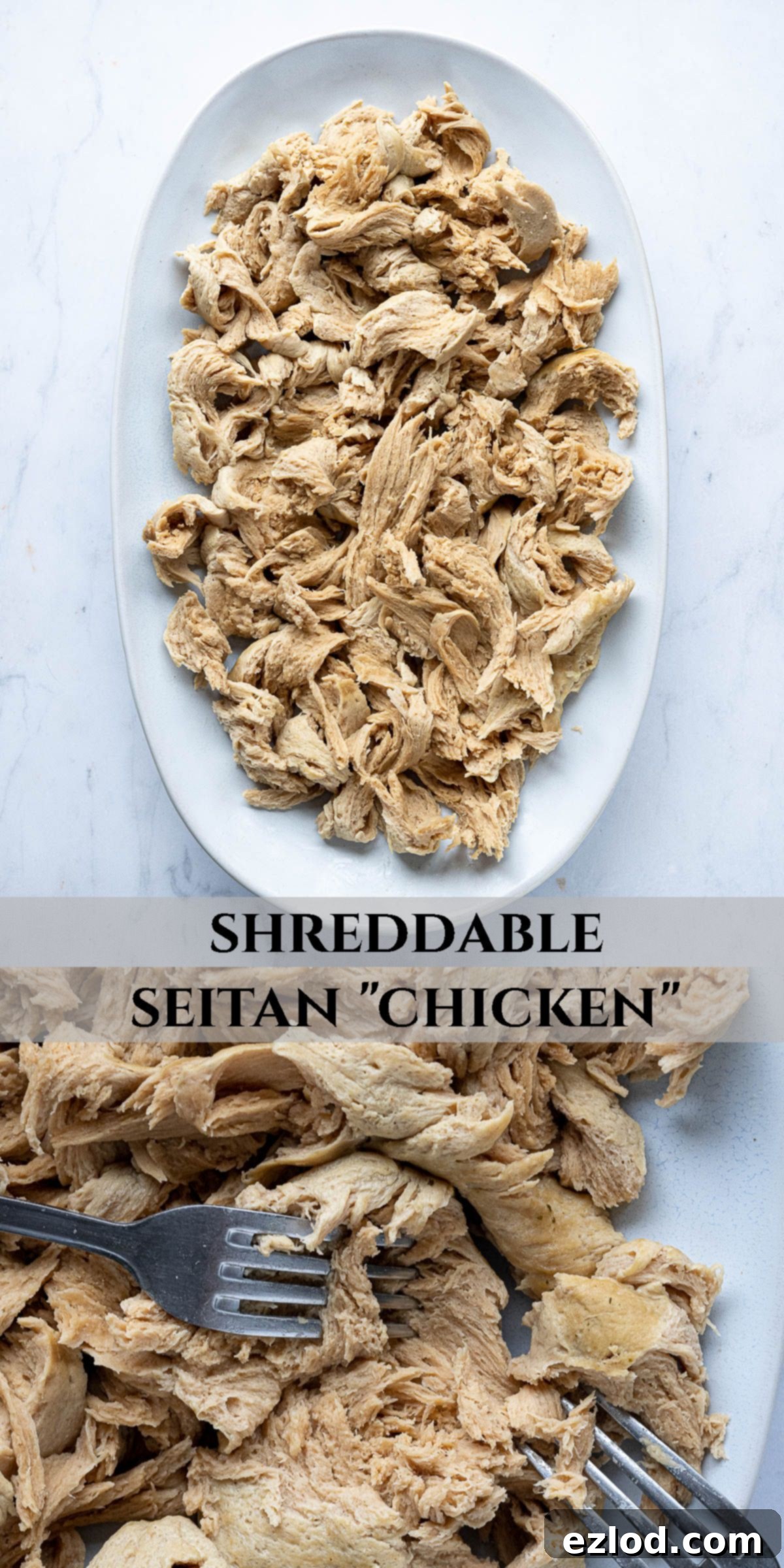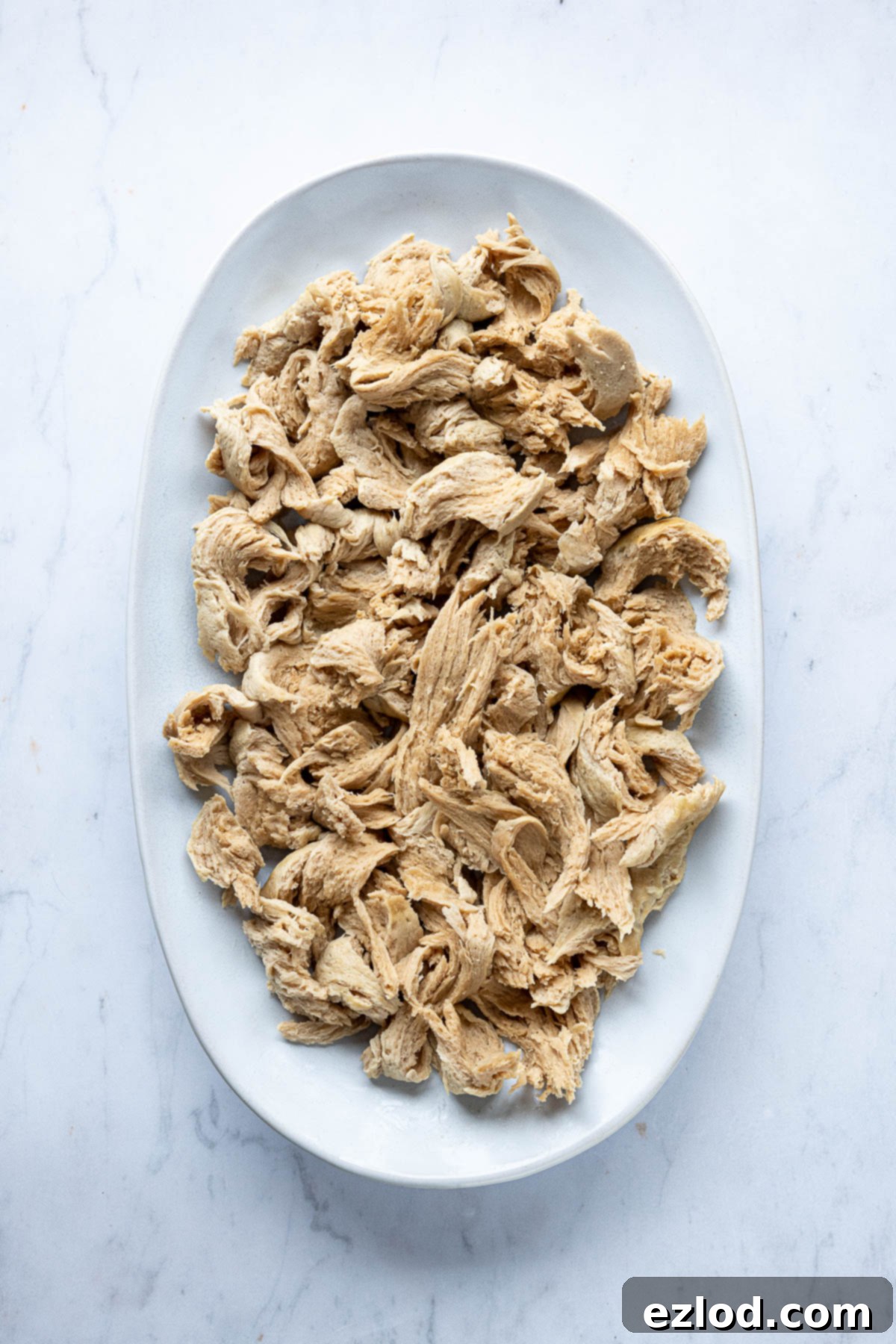Ultimate Slow Cooker Shredded Seitan Chicken: Your Guide to Perfect Vegan ‘Chick’n’
Welcome to the definitive guide for making incredible shreddable seitan chicken! This slow cooker vegan chicken-style seitan boasts an authentic meaty texture, pulls apart beautifully, and is infused with a delicious, versatile flavor that will elevate any dish. If you’re looking for a plant-based meat alternative that truly delivers on texture and taste, you’ve come to the right place.
Our slow cooker method ensures a tender, fibrous seitan that mimics real chicken effortlessly. Its neutral yet savory seasoning makes it incredibly adaptable – ready to soak up the flavors of your favorite sauces and spices. Use this homemade vegan chicken in all your beloved recipes, from stir-fries and fajitas to curries and sandwiches. Get ready to transform your plant-based cooking!
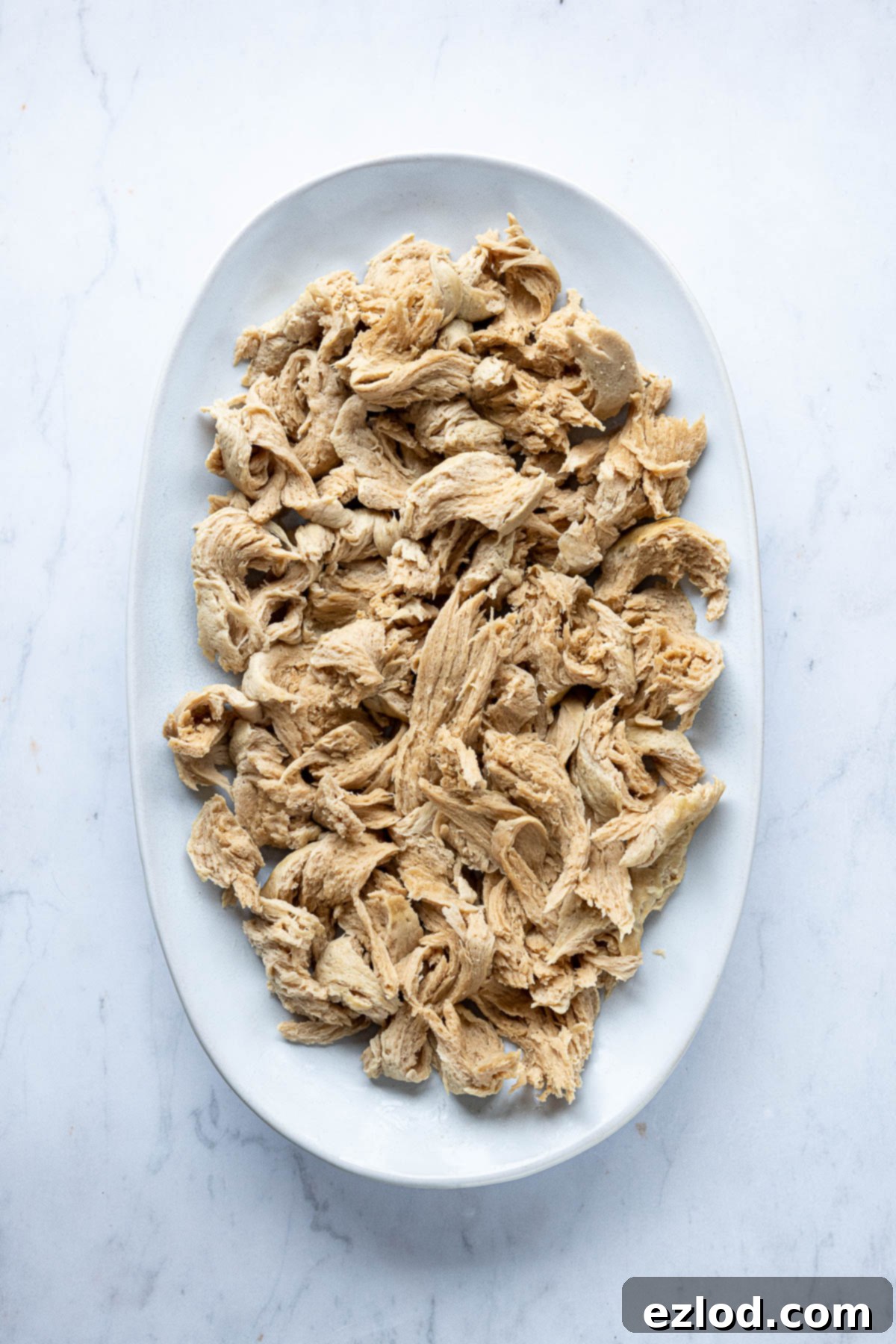
This vegan seitan chicken (often affectionately called ‘chick’n’) is an exceptionally versatile meat substitute. It’s not just for specific recipes; its delightful texture and mild flavor make it perfect for enjoying on its own or incorporating into a vast array of dishes. We’ve meticulously crafted this recipe to achieve a truly satisfying experience.
What sets this seitan apart is its remarkable meaty, fibrous, and easily pull-apart texture. Unlike some homemade seitan that can be overly tough or unpleasantly chewy, ours strikes the perfect balance – firm enough to hold its shape, yet tender enough to shred effortlessly. We’ve kept the seasoning intentionally mild, allowing you the freedom to customize its flavor profile to perfectly complement any cuisine or dish you’re preparing. Whether you’re aiming for spicy, savory, or smoky, this seitan is your ideal blank canvas.
To embark on this culinary adventure and create the best shreddable seitan chicken, you will need two key pieces of kitchen equipment: a food processor for efficient dough preparation and a slow cooker to achieve that signature tender, moist texture.
What Exactly Is Seitan? Exploring This Ancient Plant-Based Protein
Seitan (pronounced “say-tan”) is a high-protein, plant-based meat substitute derived from gluten, the primary protein component found in wheat. For this reason, it’s frequently referred to as “wheat meat” or “wheat gluten.” It’s a fantastic alternative for those seeking a protein-rich, satisfying vegan option that closely mimics the texture of animal meat.
Historically, seitan is anything but a new phenomenon. It has been a staple in Asian cuisine, particularly in China and Japan, for centuries, often enjoyed by Buddhist monks as a meat alternative due to its robust texture and high protein content. It’s a testament to its enduring appeal and versatility that it continues to be celebrated today.
Nutritionally, seitan is an impressive powerhouse. It is naturally low in fat and incredibly rich in protein, typically boasting around 75g of protein per 100g. This makes it an excellent choice for vegans, vegetarians, and anyone looking to increase their plant-based protein intake without relying heavily on soy products. Its unique composition allows it to absorb flavors remarkably well, making it highly customizable to suit virtually any taste preference or culinary application. Truly, hail seitan!
Traditionally, seitan was made using the “wash the flour” method, an ancient technique where a simple dough of flour and water is repeatedly rinsed under running water until the starches are separated, leaving behind a pure ball of concentrated wheat protein. While this method is fascinating and still practiced, a more convenient approach has become popular for home cooks: using vital wheat gluten.
Vital wheat gluten is essentially wheat flour that has already had its starch removed, resulting in a fine, concentrated protein powder. This is the ingredient we’ll be using in this recipe, simplifying the process considerably while still yielding exceptional results. It allows for a more controlled and consistent dough, perfect for achieving that desired shreddable, meaty texture without the laborious rinsing process.
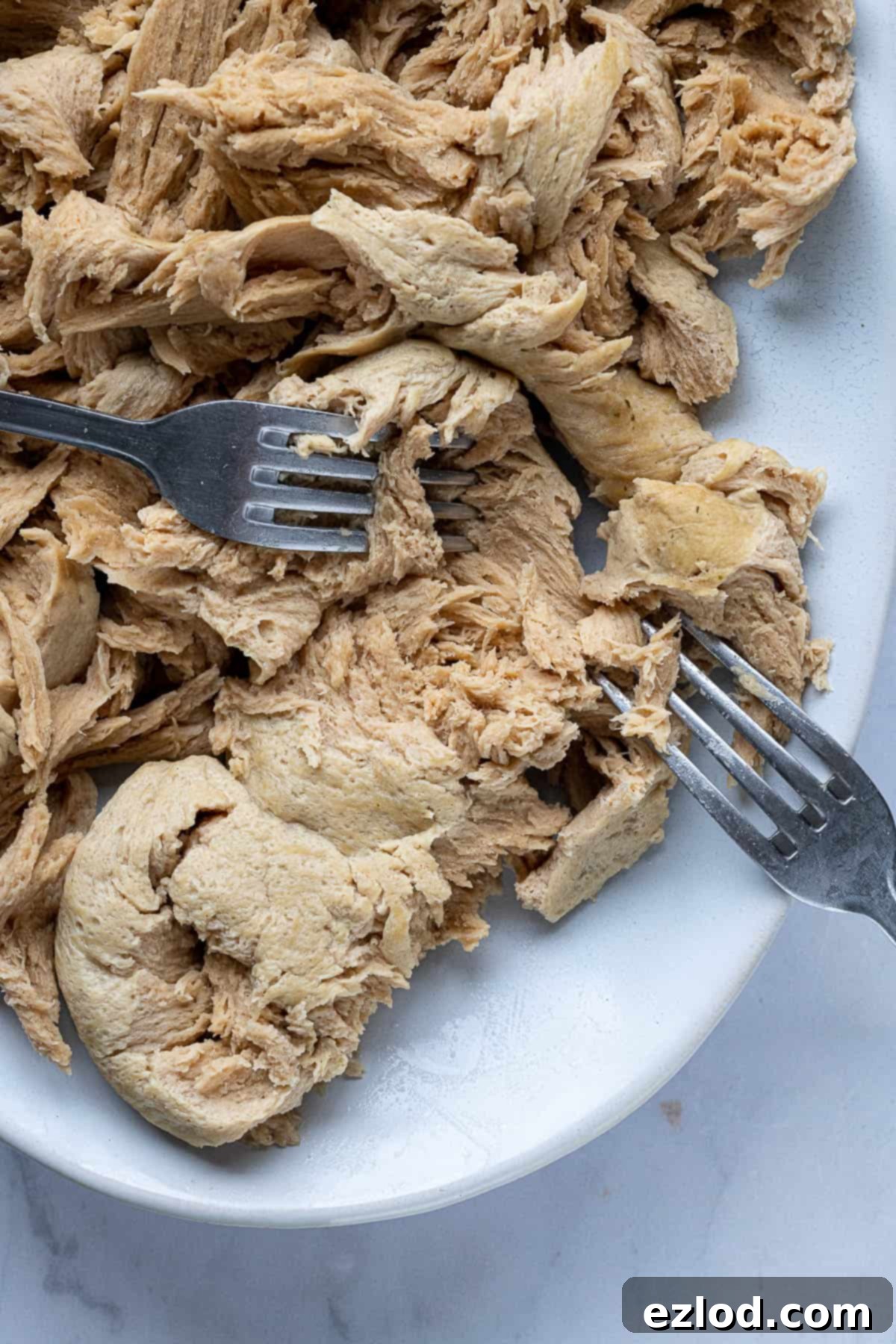
Essential Ingredients for Perfect Shredded Seitan Chicken:
Crafting this incredible slow cooker seitan chicken requires a few specific ingredients, each playing a crucial role in achieving its signature flavor and texture:
- Vital Wheat Gluten: This is the absolute cornerstone of seitan production and is non-negotiable for this recipe. Vital wheat gluten is concentrated wheat protein in a powdered form. It’s what gives seitan its characteristic elasticity, chew, and ability to form a meat-like texture. You can readily find it online, in many health food stores, or even in the baking aisle of larger supermarkets. There is no suitable substitute for vital wheat gluten in a seitan recipe.
- Cannellini Beans: To enhance the seitan’s texture, making it less rubbery and more succulent, we incorporate an additional source of protein and moisture. Cannellini beans are an excellent choice here. We use a full 400g (14 oz) tin, including the aquafaba (the liquid in the can), which is blended into a smooth mixture with the other wet ingredients before the vital wheat gluten is added. This step contributes significantly to the tender, shreddable quality of the final product. If cannellini beans aren’t available, an entire tin of butter beans or chickpeas can be used as a suitable alternative, offering similar textural benefits.
- Oil: A touch of oil is essential for improving the overall mouthfeel and tenderness of the seitan. It helps to prevent the seitan from becoming too dry or tough during the cooking process. While olive oil is my preferred choice for its subtle flavor, any neutral-tasting oil, such as canola, sunflower, or avocado oil, will work perfectly.
- Miso Paste: White miso paste is a secret weapon for adding incredible depth and umami flavor to this vegan chicken. Its fermented notes provide a complex savory base that truly elevates the taste, making the seitan taste richer and more satisfying. I strongly advise against omitting this ingredient, as it contributes significantly to the overall deliciousness.
- Lemon Juice: Introducing a touch of acidity is crucial for balancing the flavors and, importantly, for mitigating any subtle “gluteny” or “wheaty” notes that might otherwise be present. Lemon juice complements the ‘chicken-style’ flavor profile beautifully, adding a bright, fresh dimension. If you don’t have lemon juice on hand, apple cider vinegar is another excellent acidic option that works wonderfully.
- Seasonings: The beauty of this recipe lies in its adaptability, and the seasonings are where you can truly make it your own. My preferred blend for a chicken-like flavor includes nutritional yeast (for a cheesy, umami boost), garlic powder, and onion powder. Additionally, incorporating a dedicated vegan chicken seasoning blend, such as Tropical Sun, further enhances the authentic taste. This recipe is intentionally mildly seasoned to ensure its versatility across various dishes. However, if you plan to enjoy the seitan on its own or as a standalone component, feel free to increase the seasoning amounts to your liking.
- Stock: The seitan will be slow-cooked in a flavorful liquid, which is critical for infusing it with taste and maintaining its moisture. Either a good quality vegetable stock or a dedicated vegan chicken-flavored stock will work well. Ensure you have enough to fully submerge the seitan pieces in your slow cooker.
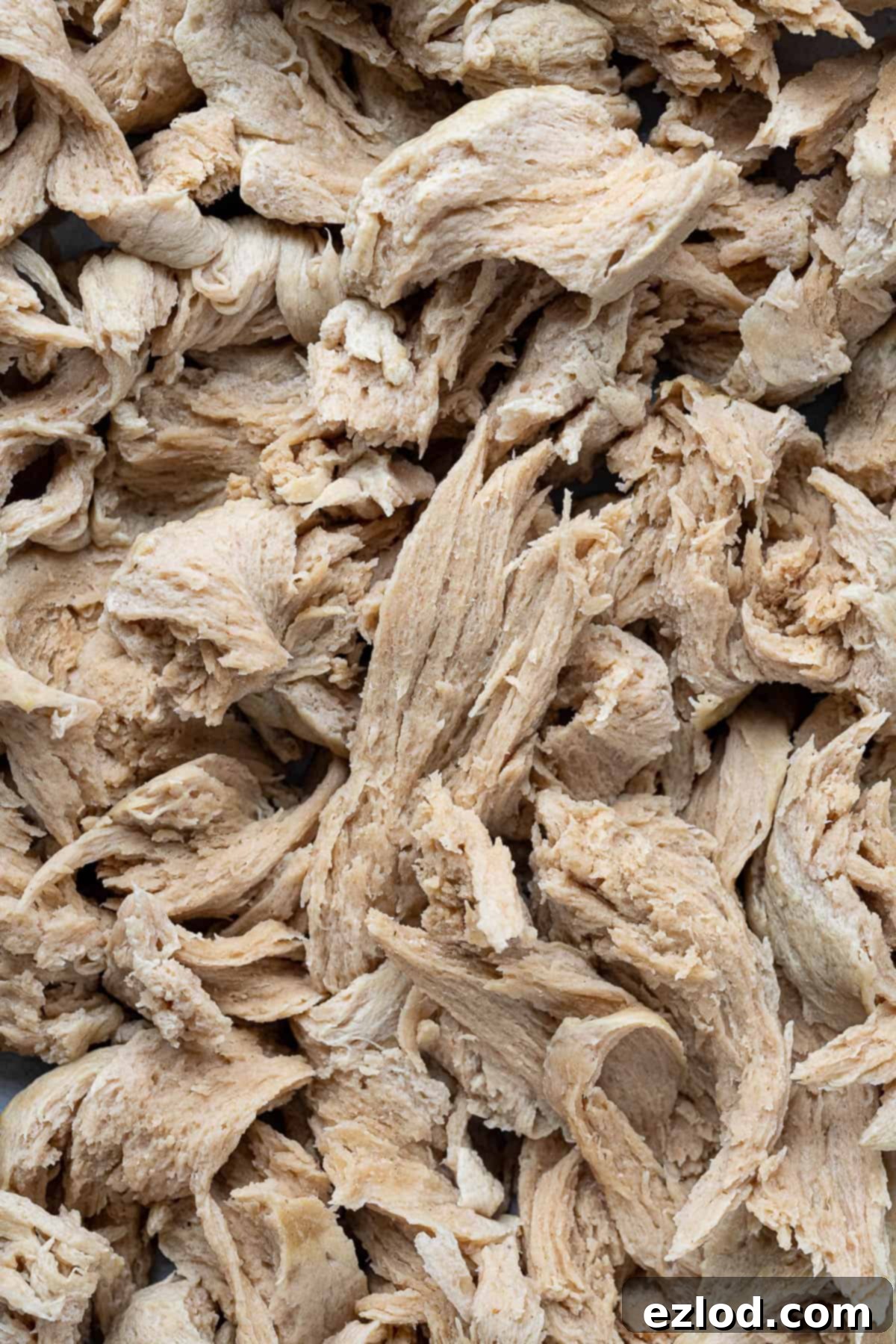
Step-by-Step: Crafting Your Shredded Seitan Chicken
(For precise measurements and detailed instructions, please refer to the recipe card located at the bottom of this page.)
1. Prepare the Wet Ingredients: Begin by tipping the entire tin of cannellini beans, including all the liquid (aquafaba), into your food processor. The aquafaba adds essential moisture and helps bind the mixture. Next, add the olive oil, lemon juice, white miso paste, nutritional yeast, garlic powder, onion powder, chicken seasoning, and salt. Process these ingredients until the mixture is completely smooth and creamy. Ensure there are no large bean chunks remaining, as this smooth base is crucial for the seitan’s final texture.
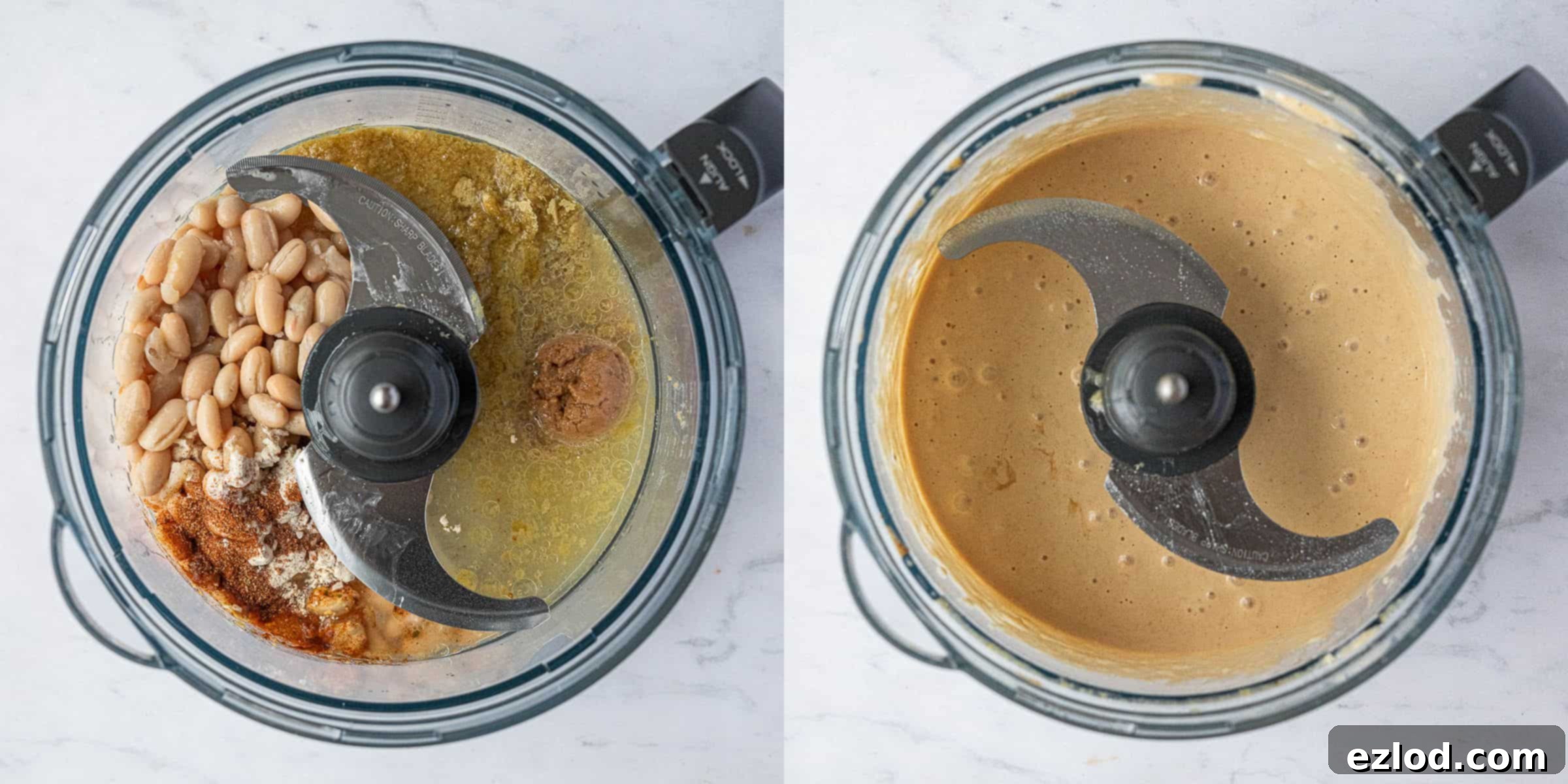
2. Form the Dough: With the wet ingredients smoothly blended, it’s time to add the vital wheat gluten. Sprinkle it evenly over the wet mixture in the food processor. Pulse and blend until the vital wheat gluten is fully incorporated and a cohesive dough begins to form. It will initially look a bit crumbly but will quickly come together.
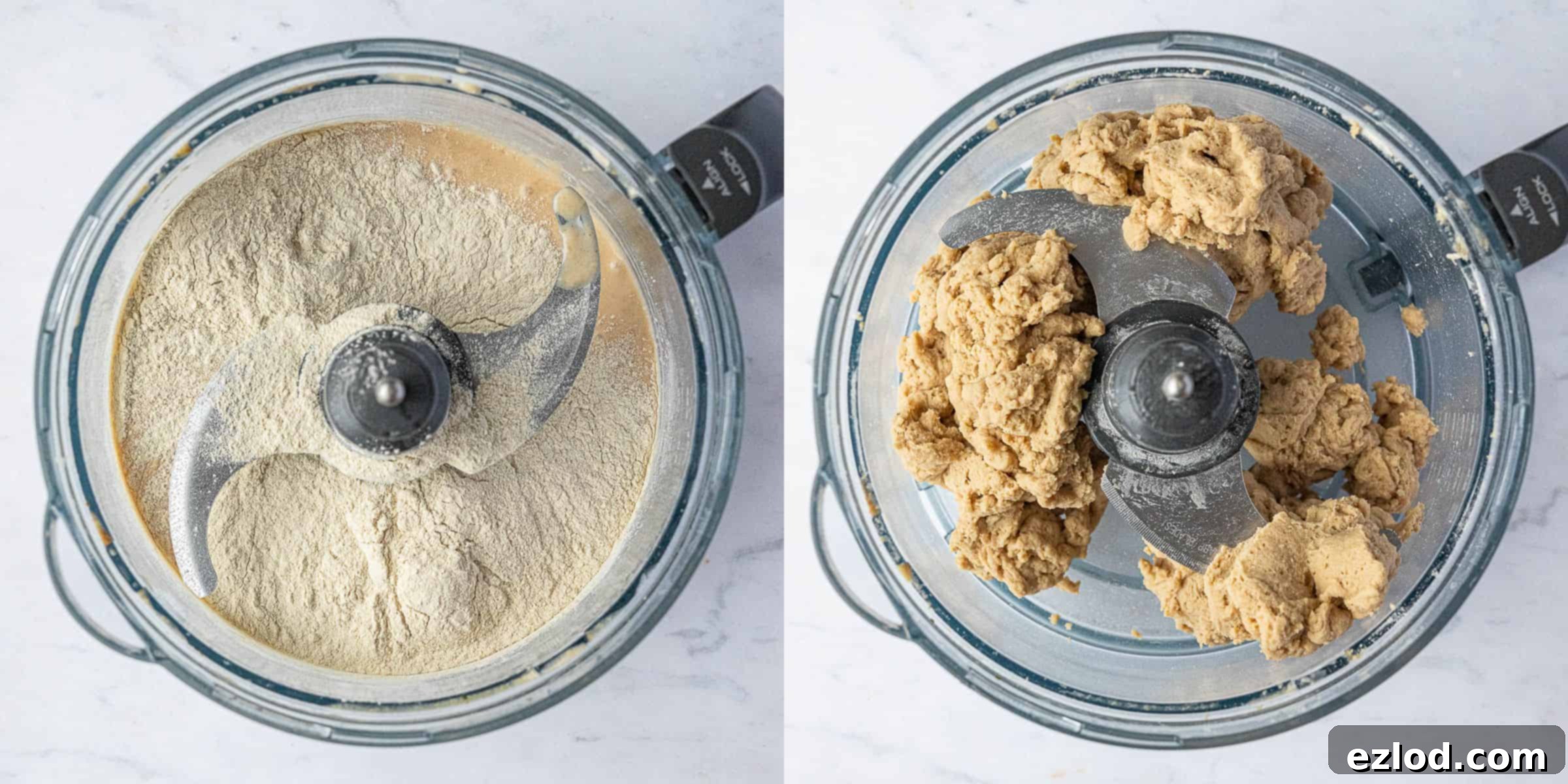
3. Develop the Gluten: This step is key to achieving the desired shreddable texture. Divide the dough into approximately three equal portions. Work with one portion at a time in the food processor, blending it for about two minutes. During this process, the dough will transform: it will become noticeably smoother, more elastic, and will start to develop a distinct stringy, fibrous texture – much like cooked chicken breast. It should feel tacky to the touch but should not stick excessively to your hands. Repeat this blending process for the remaining two portions of dough.
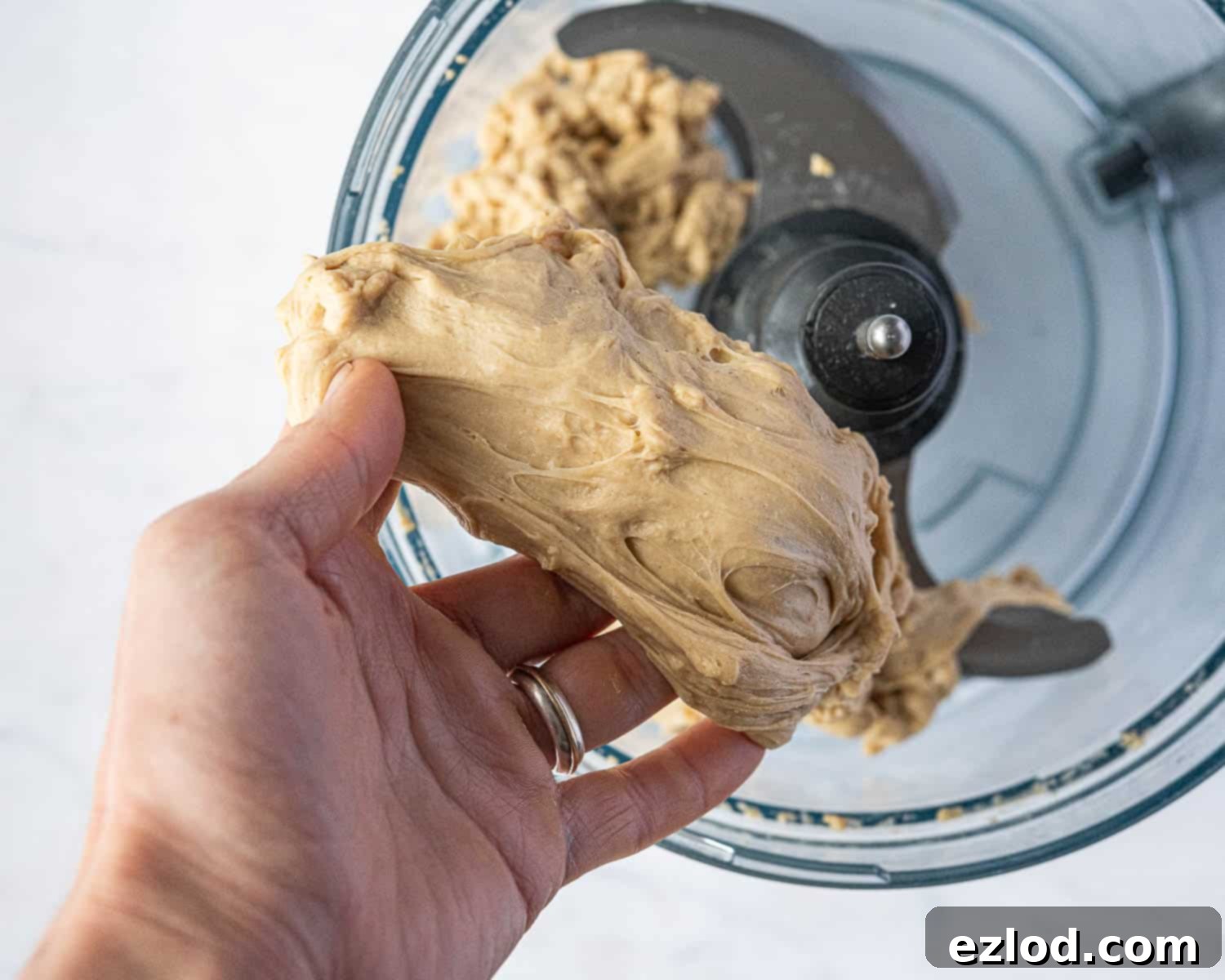
4. Shape the Seitan: Take one-third of the well-kneaded dough. Using your hands, gently stretch and roll it into a long rope, aiming for a consistent thickness. Once you have a rope, twist it tightly along its entire length. This twisting action helps create those distinct fibers that contribute to the shreddable texture after cooking.
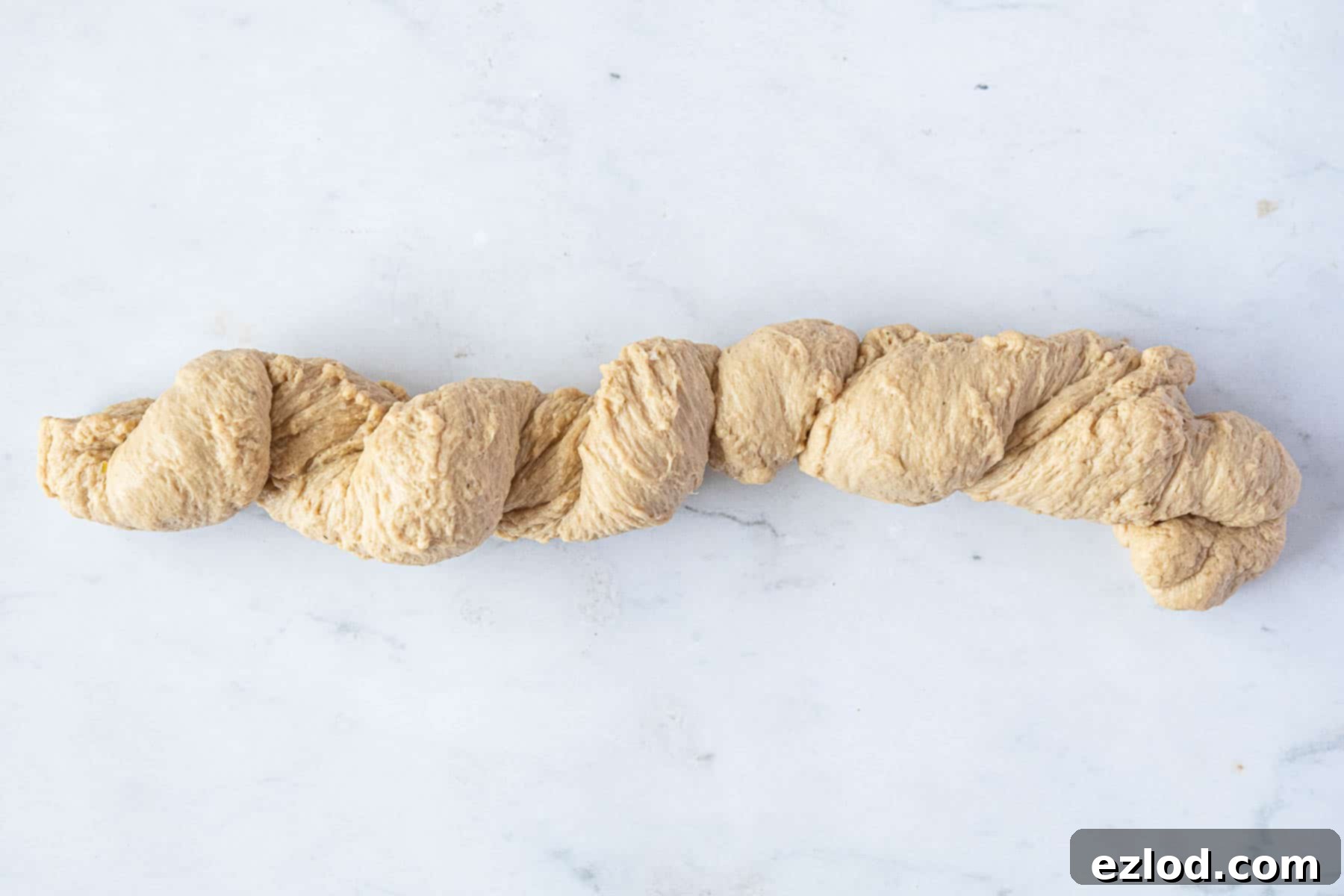
5. Secure the Shape: To ensure the seitan maintains its twisted, rope-like form during cooking, tie each end of the twisted rope into a knot. This creates a secure, somewhat oblong shape. Once knotted, press the entire piece firmly onto your countertop with your hand. This helps to compact the dough and ensures all parts stick together, preventing it from unraveling in the slow cooker. Repeat this shaping and knotting process for the remaining two pieces of dough.
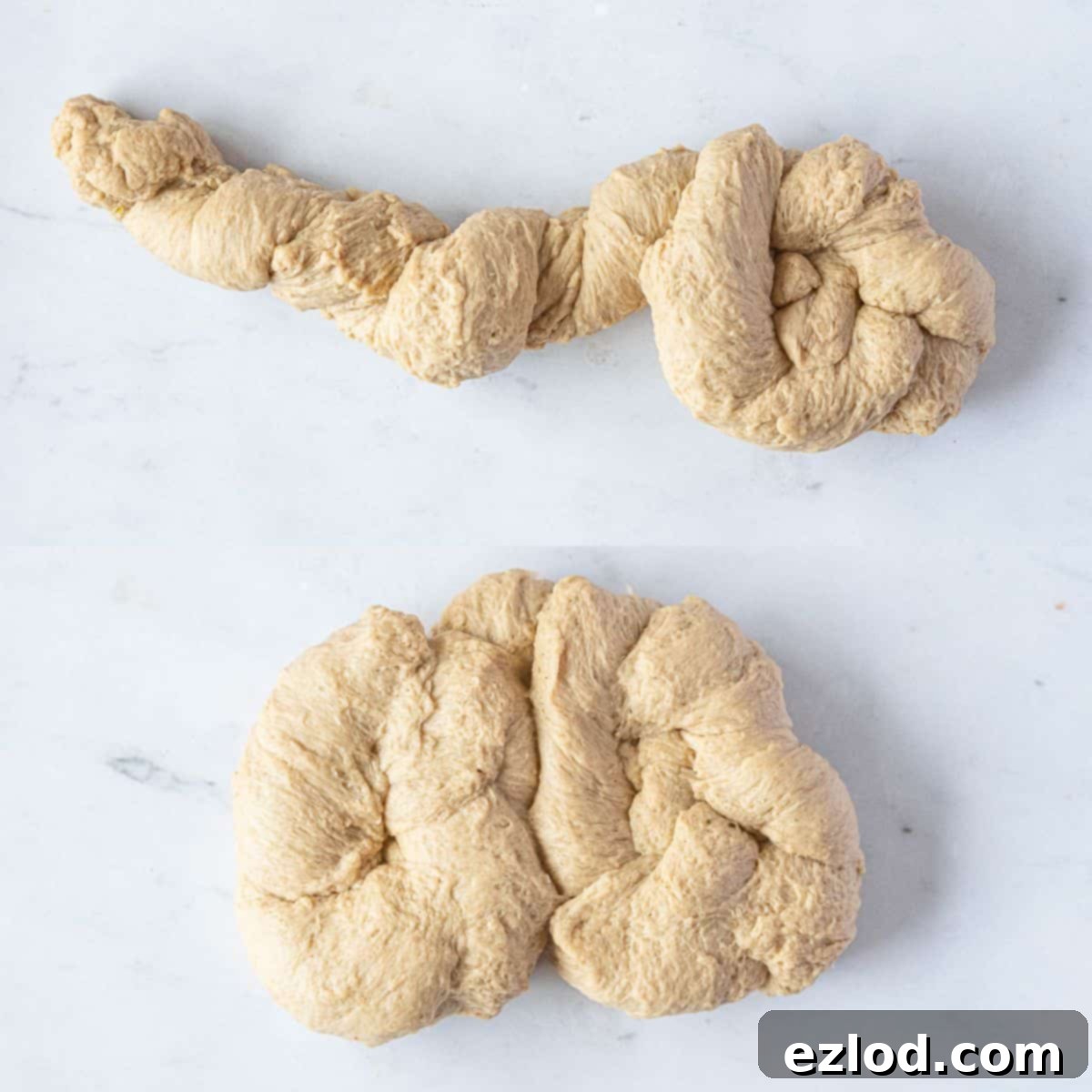
6. Prepare for Cooking: At this point, you should have three beautifully shaped pieces of seitan, ready for their slow cooker bath.
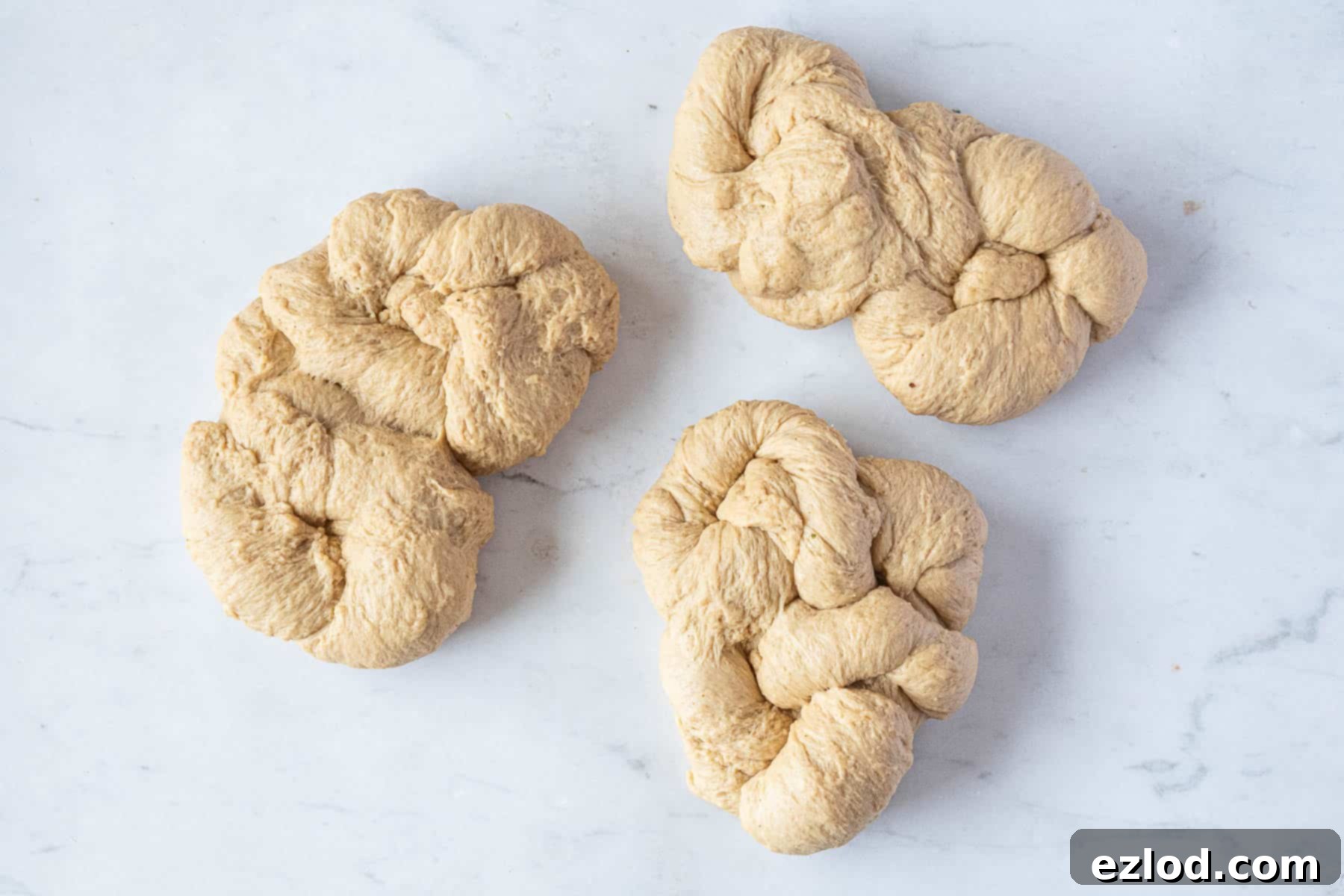
7. Slow Cooker Setup: Fill your slow cooker with hot vegetable or vegan chicken stock. Carefully place the shaped seitan pieces into the slow cooker in a single layer. It’s crucial that the seitan is fully submerged in the stock. Depending on the size and shape of your slow cooker, you may need to add a bit more hot stock to achieve this. The liquid should cover the seitan entirely to ensure even cooking and optimal moisture absorption.
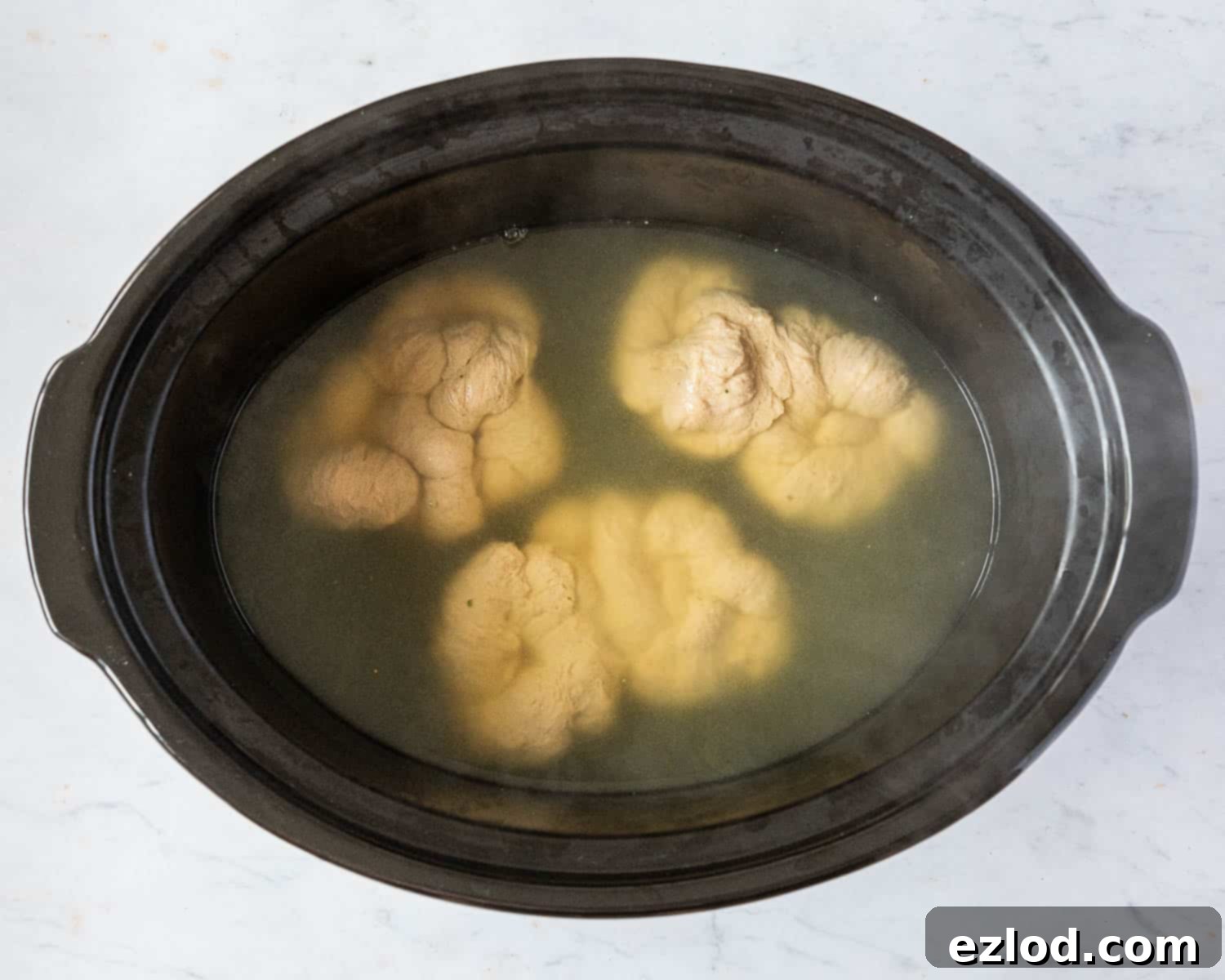
8. The Slow Cook: Cook the seitan for a total of two hours. If your slow cooker has settings, I recommend setting it to high, but always monitor to ensure the liquid maintains a gentle, low simmer – it should never boil vigorously. Excessive boiling can lead to a tough, spongy texture. Flip the seitan pieces halfway through the cooking time to ensure they cook evenly on all sides and absorb the flavorful stock uniformly.
9. Check for Doneness: As it cooks, the seitan will expand and firm up significantly. It’s ready when it feels quite firm to the touch, indicating that the gluten structure is fully developed and cooked through.
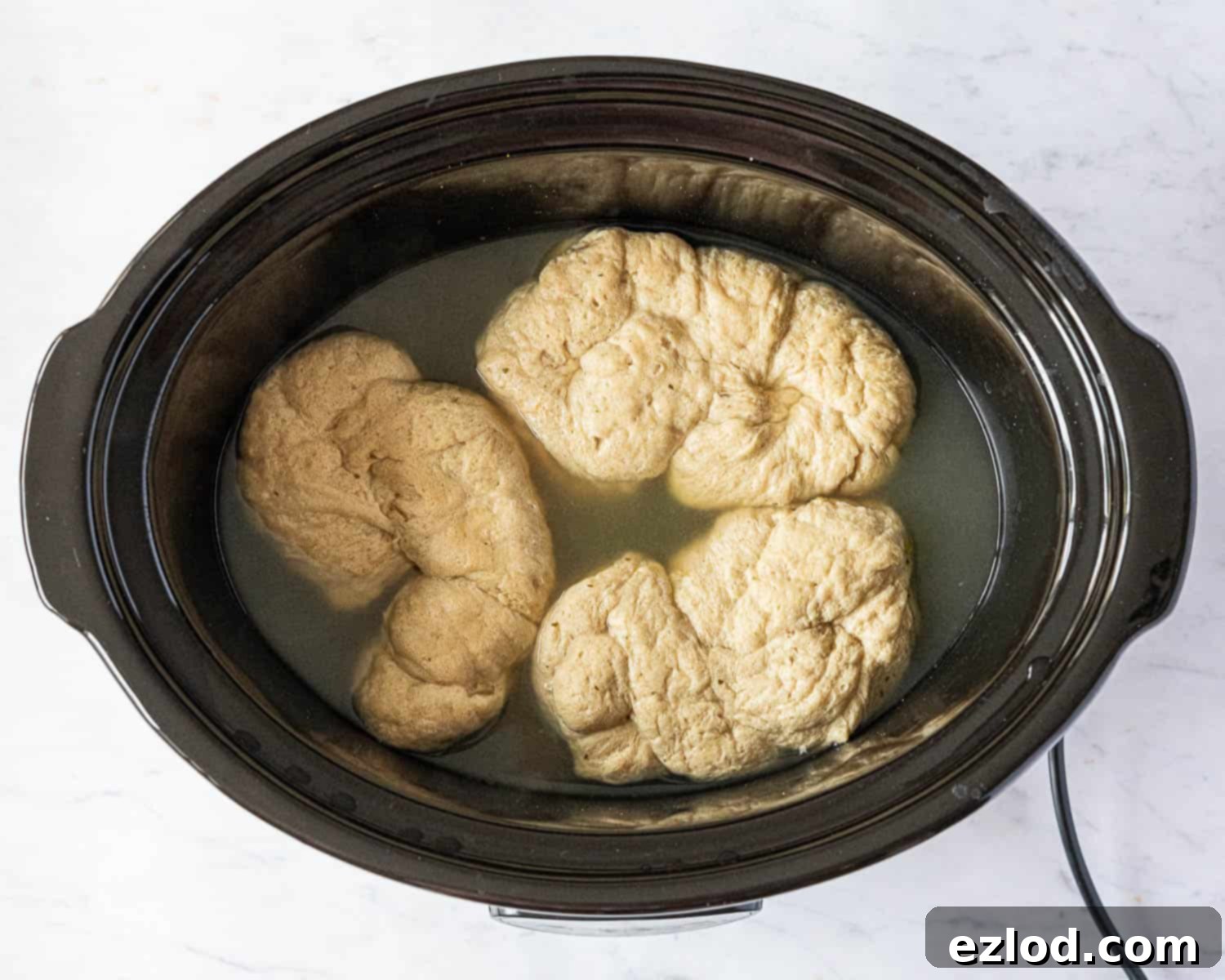
10. Shredding: Once cooked, carefully remove the seitan from the slow cooker and allow it to cool just enough so you can handle it comfortably. Shredding is much easier when the seitan is still warm, as the fibers are more pliable. Use your hands to pull it apart along its natural grain, or employ two forks to achieve your desired shred size. This will result in beautiful, tender strands perfect for any recipe.
Top Tips for Perfect Homemade Seitan Chicken
Achieving the ideal texture and flavor for your shredded seitan chicken is easier with these expert tips:
- Precision in Measuring: I cannot stress this enough – weighing your ingredients, particularly the vital wheat gluten, with a digital kitchen scale is paramount. Using cup conversions, which can be highly inaccurate due to variations in how ingredients are packed, can lead to inconsistent results. A dough that’s too wet will be sticky and hard to handle, while one that’s too dry will be crumbly and won’t develop the proper texture. Precision ensures a perfect, consistent dough every time.
- The Power of the Food Processor: A food processor is highly recommended for this recipe. Its powerful blades and rapid action efficiently develop the gluten, creating that essential stretchy, fibrous texture in minutes that would take significantly longer and more effort by hand. While you *could* attempt it in a high-powered blender, it might struggle with the thick dough. If a food processor isn’t an option, a stand mixer with a dough hook can work, or even hand-kneading, but be prepared for a much more extended and rigorous kneading process (up to 15-20 minutes) until the dough feels very firm, stretchy, and visibly stringy.
- Mind the Temperature: The golden rule for cooking seitan, especially when aiming for a tender, non-spongy texture, is to never let it come to a rolling boil. Boiling causes the gluten to seize up and become tough and rubbery. This is precisely why a slow cooker is the ideal cooking vessel for this recipe. It maintains a consistent, gentle hot temperature, ensuring the seitan simmers softly without aggressive bubbling, resulting in a juicy, perfectly textured product.
- Optimal Storage: Once cooked and cooled, your homemade seitan chicken can be stored in an airtight container in the refrigerator for up to a week. You can store it either whole or already shredded. For extra flavor, consider storing it in a small amount of the cooking broth, or in a marinade, to keep it moist and allow it to absorb even more flavor.
Can I Steam The Seitan Instead of Slow Cooking?
While I firmly believe the slow cooker method yields the juiciest and most tender seitan chicken, steaming is a viable alternative if you don’t own a slow cooker. The process is slightly different but still delivers good results.
After you’ve shaped your seitan pieces into ropes and tied them, wrap each individual piece securely in baking parchment. Then, create a second layer of wrapping using tin foil, ensuring each piece is tightly sealed into a parcel. Place these parcels into a steamer basket, positioned over a pot of boiling water. Make sure the water level is high enough to generate consistent steam but not so high that it touches the seitan parcels.
Cover the steamer with a lid and steam the seitan for approximately 1 hour and 15 minutes. Remember to flip the parcels halfway through the cooking time to ensure even cooking. Keep an eye on the water level in the pot and top it up with hot water as needed to prevent it from boiling dry. The seitan is ready when it feels notably firm to the touch, indicating it has fully cooked through.
Can I Freeze This Shredded Seitan Chicken?
Absolutely! This seitan chicken freezes exceptionally well, making it a fantastic option for meal prepping and batch cooking. To freeze, first allow the cooked seitan to cool completely. Shred it into your desired size before freezing – this makes it much easier to portion and use directly from the freezer later. Place the shredded seitan in a freezer-proof container or a resealable freezer bag, ensuring any excess air is removed to prevent freezer burn. It will maintain its quality for up to three months in the freezer. When you’re ready to use it, simply thaw overnight in the refrigerator or use directly in cooked dishes.
How to Use Your Versatile Seitan Chicken: Endless Culinary Possibilities
The beauty of this homemade shredded seitan chicken lies in its incredible versatility. It can truly replace actual chicken in almost any recipe, offering a satisfying texture and flavor. Here are just a few ideas to get you started:
- Flavorful Fry-Ups: One of my favorite ways to prepare it is by pan-frying it with some jerk seasoning. This creates a beautifully crispy exterior and a spicy, aromatic flavor perfect for fajitas or as a topping for homemade pizza.
- Sandwiches and Wraps: Pile it high in sandwiches with your favorite vegan mayo and crisp lettuce, or wrap it up in tortillas with fresh veggies and a zesty dressing.
- Stir-Fries: Add it to vibrant stir-fries for a hearty protein boost. It pairs wonderfully with a medley of colorful vegetables and your preferred Asian-inspired sauce.
- Curries and Stews: This seitan is excellent in rich curries or comforting stews, soaking up all the fragrant spices and sauces beautifully. It would be a fantastic addition to my vegan chicken potato pie, or as a substitute for chickpeas in this creamy vegetable soup, adding an extra layer of texture and protein.
- Salads and Bowls: Toss it into your favorite green salads, grain bowls, or Buddha bowls for a complete and satisfying meal.
- Tacos and Burritos: Seasoned with taco spices, it makes an amazing filling for plant-based tacos, burritos, or quesadillas.
- Skewers: Marinate and thread onto skewers with vegetables for grilling or baking.
A Little Pro Tip for Wet Dishes: If you’re adding the seitan chicken to a sauce-heavy dish like soup or curry, I recommend frying it separately first until it achieves a slight crispiness. Then, add it to the sauce towards the very end of the cooking process. This helps maintain its texture and prevents it from becoming overly soft or mushy.
Reheating Instructions: To reheat your seitan chicken, you have several convenient options. It can be quickly pan-fried for a slightly crispy finish, baked in the oven until warmed through, heated in the microwave for speed, or even cooked in an air fryer for extra crispiness.
Can I Make This Seitan Chicken Gluten-Free?
Unfortunately, no. The very essence of seitan lies in its primary ingredient: vital wheat gluten. This concentrated wheat protein is what gives seitan its unique, meat-like, and incredibly shreddable texture. Therefore, it cannot be substituted with any other ingredient to make a gluten-free version. If you are looking for gluten-free vegan meat alternatives, there are many excellent options available made from soy (like tofu or tempeh), mushrooms, or various legume-based proteins, but they will not replicate the specific qualities of seitan.
Explore More Delicious Seitan Recipes:
If you’ve fallen in love with the versatility of seitan, be sure to check out these other fantastic plant-based recipes:
- Hearty Vegan Seitan Meatloaf
- Homemade Seitan Pepperoni
- Savory Vegan Swedish Seitan Meatballs
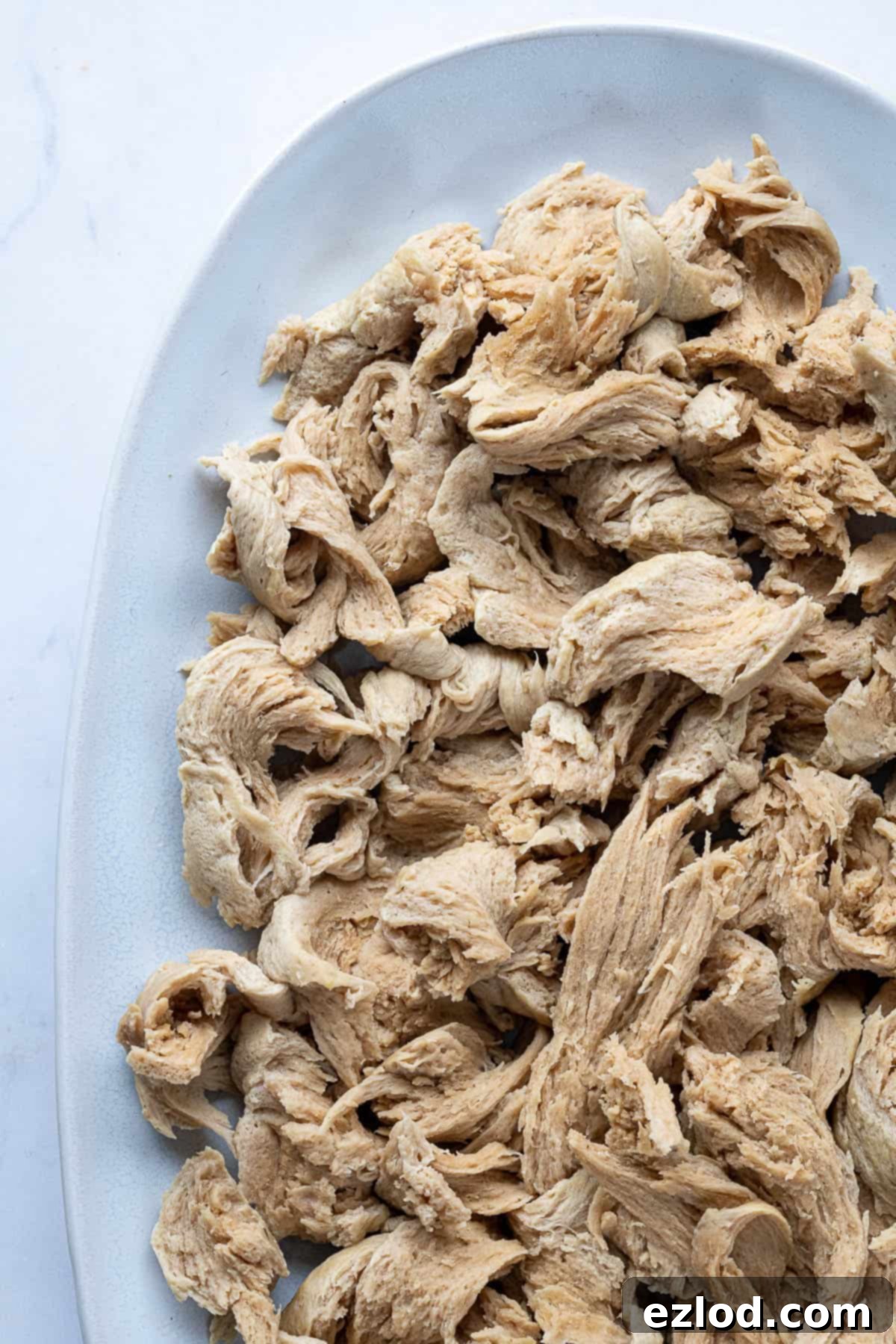
If you tried this incredible shredded seitan chicken recipe, we’d love to hear from you! Please rate it, leave a comment below, or share your creations on Instagram by tagging @domestic_gothess and using the hashtag #domesticgothess. Your feedback and photos truly make our day!
All images and content on Domestic Gothess are copyright protected. If you wish to share this recipe, please do so by using the provided share buttons. We kindly request that you do not screenshot or post the recipe or content in full. Instead, please include a direct link to this post for the complete recipe. Thank you for your understanding and support!
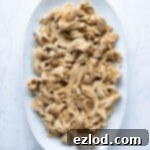
Print
Seitan “Chicken” (Vegan)
Equipment
-
food processor
-
slow cooker
Ingredients
- one entire 400 g (14 oz) tin of cannellini beans, INCLUDING the liquid
- 3 Tablespoons nutritional yeast
- 2 Tablespoons olive oil
- 1 tablespoon lemon juice
- 1 Tablespoon white miso paste
- 1 teaspoon garlic powder
- 1 teaspoon onion powder
- 1 teaspoon chicken seasoning
- ¼ teaspoon salt
- 200 g (1 + ⅔ cup) vital wheat gluten
- 1 litre hot stock (more if needed)
Instructions
-
Tip the whole tin of beans, liquid and all, into a food processor fitted with a metal blade. Add the oil, lemon juice, miso paste, nutritional yeast, garlic and onion powders, chicken seasoning and salt and blend until smooth.
-
Add the vital wheat gluten and blend until it forms a dough.
-
Working with about ⅓ rd of the dough at a time, blend the dough for a couple of minutes until it becomes very smooth and stretchy, with a stringy, fibrous looking texture. It should feel tacky but should not stick to your hands. Repeat with the rest of the dough.
-
Take ⅓ rd of the kneaded dough and stretch it into a long rope with your hands. Twist the rope tightly.
-
Tie each end into a knot so that it sort of forms one piece. Press it firmly with your hand on the counter top so that it all sticks together. Repeat with the other two pieces of dough.
-
Fill a slow cooker with hot stock and add the pieces of seitan in a single layer. There should be enough stock to cover them so you may need to add a bit more depending on the size of your slow cooker.
-
Cook for two hours, flipping halfway through. I have mine set to high but this may vary depending on your slow cooker. You want it to stay at a low simmer, not bubble too much and never boil.
-
The seitan will expand as it cooks, it is ready when it feels quite firm.
-
Allow the seitan to cool enough that you can handle it, then either use your hands or two forks to pull it apart into shreds. It is easier to do this while it is still warm. Store in an airtight container in the fridge for up to a week.
Notes
- See post above for tips, details and step-by-step photos.
- I highly, highly recommend weighing out the vital wheat gluten using a digital scale rather than using the cup conversion. You will get a far better, more consistent result. Cups are a very innaccurate measuring system and you may end up with dough that is either too wet or too dry.
- Recipe inspired by https://avocadosandales.com/2017/12/17/chickwheat-shreds/ and Crafting Seitan by Skye Michael Conroy.
